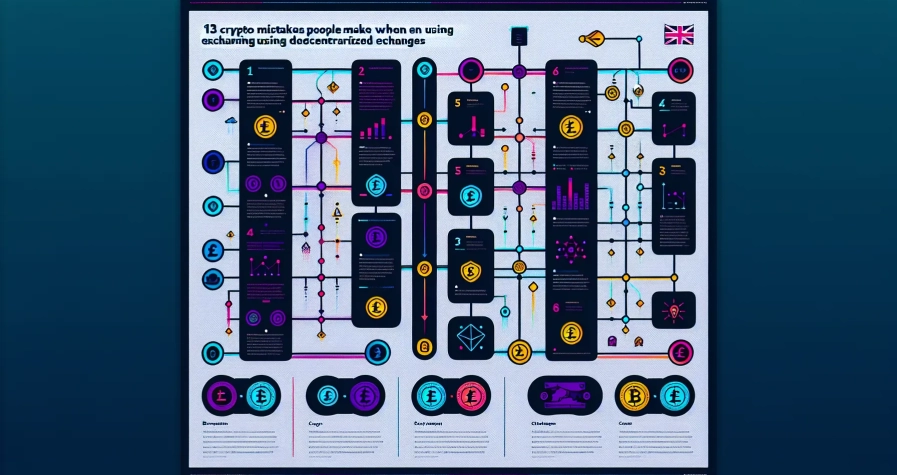Key Takeaways
- Crypto market cycles are predictable patterns spanning 2-4 years, consisting of four distinct phases: accumulation (stable prices, low volume), uptrend (300-1000% gains), distribution (volatile peaks), and downtrend (70-90% declines from peaks).
- Market psychology drives cycle progression, with fear and greed alternating as dominant forces—FOMO pushes prices higher during bull markets whilst panic selling accelerates bear market declines, creating self-reinforcing patterns.
- External factors significantly influence cycle timing, including regulatory developments, technological advancements, Bitcoin halving events, and macroeconomic conditions that can extend or accelerate phase transitions beyond typical timeframes.
- Technical and on-chain analysis helps identify current phases through indicators like RSI, MACD, trading volumes, exchange reserves, and network activity metrics, enabling better timing of investment decisions.
- Phase-specific strategies optimise returns and manage risk, from building positions during accumulation (60-80% allocation) to preserving capital during mark-downs (10-30% allocation), with disciplined profit-taking throughout growth phases.
- Historical cycles demonstrate consistent patterns, as seen in the 2017-2018 and 2020-2022 cycles, where similar psychological and fundamental drivers created comparable price movements and market behaviours across different time periods.
You’ve probably noticed that cryptocurrency prices don’t move in straight lines. They rise dramatically, crash spectacularly, then repeat the process with surprising regularity. These aren’t random events – they’re part of predictable patterns called crypto market cycles.
Understanding these cycles can transform how you approach cryptocurrency investing. Each cycle follows distinct phases that repeat throughout market history, driven by factors like investor psychology, regulatory changes, and technological developments. Bitcoin halvings, market sentiment shifts, and adoption waves all play crucial roles in shaping these recurring patterns.
Whether you’re a seasoned trader or just starting your crypto journey, recognising where the market sits within these cycles can help you make more informed decisions. You’ll discover how to identify cycle phases, what triggers major market movements, and why these patterns continue to influence cryptocurrency markets worldwide.
What Are Crypto Market Cycles?
Crypto market cycles represent recurring patterns of price movements across the cryptocurrency ecosystem that typically span 2-4 years. These cycles consist of four distinct phases: accumulation, uptrend, distribution, and downtrend, each characterised by specific market behaviours and trading volumes.
During the accumulation phase, prices remain relatively stable whilst institutional investors and experienced traders quietly build positions. Trading volumes stay low, and mainstream media coverage decreases significantly. This phase often lasts 6-12 months and represents the foundation for the next bull market.
The uptrend phase marks rapid price appreciation as retail investors enter the market. Media attention increases, new projects launch frequently, and FOMO (fear of missing out) drives speculative buying. Bitcoin and major altcoins typically see 300-1000% gains during this 12-18 month period.
Distribution occurs when early investors take profits whilst newcomers continue buying at peak prices. Market sentiment remains optimistic despite underlying weakness in fundamentals. This phase lasts 3-6 months and signals the approaching end of the bull market.
The downtrend phase brings significant price corrections, often 70-90% from peak values. Retail investors exit positions at losses, trading volumes decline, and regulatory scrutiny increases. Bear markets typically persist for 12-18 months before the cycle begins anew.
| Phase | Duration | Price Movement | Volume | Sentiment |
|---|---|---|---|---|
| Accumulation | 6-12 months | Stable/slight decline | Low | Neutral |
| Uptrend | 12-18 months | 300-1000% gains | Increasing | Optimistic |
| Distribution | 3-6 months | Volatile peaks | High | Mixed |
| Downtrend | 12-18 months | 70-90% decline | Decreasing | Pessimistic |
Understanding these patterns helps you identify optimal entry and exit points, though timing the market perfectly remains challenging even for experienced traders. External factors like regulatory announcements, technological developments, and macroeconomic conditions can accelerate or extend each phase beyond typical timeframes.
The Four Phases of Crypto Market Cycles
Each crypto market cycle unfolds through four distinct phases that form recurring patterns in cryptocurrency markets. These phases – accumulation, mark-up, distribution and mark-down – create predictable opportunities for investors who understand their characteristics.
Accumulation Phase
The accumulation phase begins after a significant market downturn when cryptocurrency prices stabilise at low levels. You’ll notice subdued trading volume and bearish sentiment dominating market discussions during this 6-12 month period. Institutional investors and experienced traders quietly build their positions while retail sentiment remains negative from previous losses.
Price movements stay relatively flat with minimal volatility as the market consolidates. Smart money accumulates assets anticipating future growth whilst mainstream media attention remains minimal. This phase offers the most favourable risk-reward entry points for long-term holders seeking to position themselves before the next upward cycle begins.
Mark-Up Phase
Market confidence returns during the mark-up phase as prices begin rising steadily over 12-18 months. You’ll observe increased trading volume and growing market participation as sentiment shifts from negative to positive. Technological developments, positive regulatory news or macro events like Bitcoin halving often trigger this upward momentum.
Cryptocurrency prices advance towards and beyond previous highs with gains of 300-1000% becoming common for Bitcoin and major altcoins. Media coverage increases whilst institutional adoption grows, attracting new investors to the market. This phase represents the main wealth creation period for those who accumulated during the previous downturn.
Distribution Phase
Extreme optimism characterises the distribution phase as prices rise rapidly in parabolic fashion over 3-6 months. FOMO (fear of missing out) drives mainstream attention and speculative capital into cryptocurrency markets. You’ll witness intense media coverage creating speculative bubbles as greed dominates investor psychology.
Early investors begin taking profits whilst new buyers enter at peak prices despite weakening market fundamentals. High leverage trading becomes widespread as retail investors chase rapidly appreciating assets. This phase presents elevated risk as prices reach unsustainable levels driven by speculation rather than underlying value.
Mark-Down Phase
Sharp corrections define the mark-down phase as cryptocurrency prices decline 70-90% from their peaks over 12-18 months. Fear dominates market sentiment causing widespread selling pressure and reduced buying interest. You’ll experience significant portfolio drawdowns as speculative positions unwind rapidly.
Retail investors often exit at substantial losses whilst trading volumes decline dramatically. Media narratives turn negative as previous enthusiasm transforms into scepticism about cryptocurrency’s future. This phase persists until market conditions stabilise and institutional investors begin accumulating again, setting the foundation for the next cycle to begin.
Key Drivers Behind Crypto Market Cycles
Market cycles don’t occur in isolation but result from specific forces that shape investor behaviour and price movements. Understanding these drivers helps you anticipate potential market shifts and position your investments accordingly.
Market Psychology and Investor Sentiment
Emotions drive the majority of cryptocurrency trading decisions, creating predictable patterns across market cycles. Fear and greed alternate as dominant forces, with FOMO (fear of missing out) pushing prices 300-500% higher during bull markets whilst panic selling accelerates 70-90% price declines in bear phases.
Sentiment indicators like the Crypto Fear & Greed Index fluctuate between extreme fear (0-25) during accumulation phases and extreme greed (75-100) at distribution peaks. Social media mentions, Google search trends, and retail participation rates amplify these psychological swings, often creating self-reinforcing cycles where positive sentiment attracts more buyers and negative sentiment triggers mass exits.
Herd mentality becomes particularly evident during phase transitions, with retail investors typically entering markets during mark-up phases when prices have already risen significantly and exiting during mark-down phases after substantial losses.
Regulatory Developments and News Events
Government policies and regulatory announcements create immediate and lasting impacts on crypto market cycles. Positive regulatory clarity, such as Bitcoin ETF approvals or institutional adoption frameworks, can extend bull market phases by 6-12 months whilst regulatory crackdowns can accelerate bear market conditions.
Major economies’ regulatory stances carry disproportionate weight, with announcements from the US, European Union, and China often triggering 20-40% price movements within 24-48 hours. Countries implementing crypto-friendly legislation like El Salvador’s Bitcoin adoption or the UK’s digital asset frameworks typically coincide with extended accumulation or early mark-up phases.
News events beyond regulation also influence cycles, including institutional investments, corporate treasury adoptions, and macroeconomic factors like inflation rates and traditional market performance. These external catalysts often determine the timing and intensity of cycle transitions.
Technological Advancements and Adoption
Blockchain improvements and cryptocurrency adoption rates directly correlate with market cycle progression. Network upgrades like Ethereum’s transition to proof-of-stake or Bitcoin’s Lightning Network development often trigger renewed investor interest during accumulation phases.
Real-world utility expansions, including payment integrations, DeFi protocol launches, and NFT marketplace growth, provide fundamental support for sustained price increases during mark-up phases. Transaction volumes, active wallet addresses, and developer activity serve as leading indicators of technological momentum.
Infrastructure developments such as improved exchanges, custody solutions, and trading platforms reduce barriers to entry, enabling broader participation and extending cycle durations. Conversely, technological setbacks, security breaches, or scalability issues can prematurely end bull markets and accelerate bear market conditions.
Historical Examples of Crypto Market Cycles
Examining past crypto market cycles provides concrete examples of how these patterns unfold in real-world scenarios. Two prominent cycles demonstrate the dramatic price swings and predictable phases that characterise cryptocurrency markets.
The 2017-2018 Bull and Bear Cycle
The 2017-2018 cycle represents one of the most dramatic examples of crypto market volatility you can study. Bitcoin surged from approximately $1,000 in January 2017 to nearly $20,000 by December 2017, delivering gains of over 1,900% during the mark-up phase.
This bull run gained momentum through several key factors:
- ICO boom drove massive speculation as investors poured billions into new blockchain projects
- Mainstream media coverage brought unprecedented attention to cryptocurrencies
- Retail investor FOMO created a speculative bubble as everyday investors entered the market
- Exchange listings of new altcoins multiplied trading opportunities
The distribution phase peaked in December 2017 when Bitcoin reached $19,783, marking the cycle’s highest point. However, the subsequent crash was equally severe, with Bitcoin losing over 80% of its value by December 2018, falling to approximately $3,200.
Regulatory concerns from major economies and market corrections triggered this prolonged bear market, which lasted throughout 2018 and into 2019. The entire cycle demonstrated classic market psychology, from early accumulation by experienced investors to mass retail participation at peak prices.
The 2020-2022 Market Cycle
The 2020-2022 cycle showcased how external economic factors can amplify crypto market movements. Bitcoin’s price climbed from around $10,000 in October 2020 to peak at approximately $69,000 in November 2021, representing gains of nearly 600%.
Several unprecedented factors drove this bull market:
- Institutional adoption accelerated as companies like Tesla and MicroStrategy added Bitcoin to their balance sheets
- COVID-19 monetary policy created massive liquidity expansion, driving investors toward alternative assets
- El Salvador’s legal tender adoption provided legitimacy and sparked sovereign interest
- DeFi explosion created new use cases and investment opportunities across blockchain ecosystems
The peak occurred in November 2021, followed by a severe correction throughout 2022. Bitcoin’s price dropped approximately 78% from its all-time high, falling to around $15,500 by November 2022.
Key factors that triggered the bear market included:
| Factor | Impact |
|---|---|
| Federal Reserve rate hikes | Reduced liquidity in risk assets |
| China’s mining ban | Created regulatory uncertainty |
| Luna/Terra collapse | Undermined market confidence |
| FTX exchange failure | Triggered widespread institutional distrust |
This cycle illustrated how quickly market sentiment can shift from extreme optimism to fear, with the mark-down phase lasting approximately 12 months and wiping out over $2 trillion in total crypto market capitalisation.
How to Identify Current Market Cycle Phases
You can identify the current phase of a crypto market cycle by analysing price trends, volatility patterns, and investor sentiment indicators. Low and stable prices typically suggest accumulation phases, whilst rapid price increases with high volatility point to distribution phases.
Technical Analysis Indicators
Technical indicators provide quantitative tools to assess market conditions and identify potential phase transitions. You’ll find these indicators particularly effective when used in combination rather than isolation.
RSI (Relative Strength Index) measures overbought and oversold conditions across a 0-100 scale. RSI values above 70 signal overbought conditions and potential pullbacks during distribution phases, whilst values below 30 indicate oversold conditions and buying opportunities during mark-down phases.
MACD (Moving Average Convergence Divergence) detects momentum changes and trend reversals through signal line crossings. When MACD crosses above its signal line, it indicates bullish momentum supporting mark-up phases, whilst crossings below suggest bearish momentum during mark-down periods.
Bollinger Bands measure market volatility and price extremes relative to moving averages. Price action near upper bands suggests overbought conditions during distribution phases, whilst price movement near lower bands indicates oversold conditions typical of accumulation phases.
| Indicator | Optimal Range | Phase Indication |
|---|---|---|
| RSI | Above 70 | Distribution (overbought) |
| RSI | Below 30 | Mark-down/Accumulation (oversold) |
| MACD | Above signal line | Mark-up (bullish momentum) |
| MACD | Below signal line | Mark-down (bearish momentum) |
| Bollinger Bands | Price at upper band | Distribution (potential reversal) |
| Bollinger Bands | Price at lower band | Accumulation (potential bottom) |
Trading volume confirms the strength of price movements across all phases. High volume during uptrends supports mark-up phases, whilst declining volume during price drops may signal weakening bearish trends and approaching accumulation phases.
On-Chain Metrics and Data
On-chain analysis provides unique insights into blockchain network activity and investor behaviour patterns. These metrics offer fundamental data unavailable in traditional markets.
Bitcoin halving events occur approximately every four years, reducing miner rewards by 50% and historically coinciding with new bull market cycles. These events decrease new Bitcoin supply entering the market, creating supply-demand imbalances that drive price appreciation during subsequent mark-up phases.
Hash rate fluctuations indicate network security levels and miner confidence in future profitability. Rising hash rates often signal positive sentiment and network health, potentially leading to price growth during early mark-up phases, whilst declining hash rates may indicate weakening fundamentals.
Exchange reserves tracking reveals supply dynamics through Bitcoin holdings on centralised exchanges. Declining exchange reserves reflect buyers absorbing available supply, typically observed before or during mark-up phases, whilst increasing reserves suggest selling pressure during distribution and mark-down phases.
Network activity metrics including transaction volumes and active addresses reflect growing demand and market interest. Increased on-chain activity often correlates with mark-up phases as adoption expands, whilst declining activity may signal market cooling during distribution phases.
You can combine price action analysis, technical indicators, sentiment measurements, and on-chain data to accurately identify current market cycle phases and optimise your entry or exit timing accordingly.
Strategies for Different Market Cycle Phases
Accumulation Phase Strategies
Build positions gradually during the accumulation phase when prices stabilise at low levels. This phase offers the most favourable risk-to-reward ratio for long-term investors. You should focus on dollar-cost averaging into quality cryptocurrencies whilst avoiding the temptation to time the exact bottom.
Key approaches include:
- Purchase established cryptocurrencies like Bitcoin and Ethereum when trading volumes remain subdued
- Allocate 60-80% of your investment capital during this 6-12 month period
- Monitor on-chain metrics such as network hash rate and active addresses for signs of accumulation
- Ignore negative sentiment from mainstream media and focus on fundamental developments
Growth Phase Investment Tactics
Ride the upward momentum during the mark-up phase whilst maintaining disciplined position management. This 12-18 month period requires balancing optimism with strategic profit-taking as prices climb steadily higher.
Effective strategies encompass:
- Add to winning positions incrementally as technical indicators confirm the uptrend
- Take partial profits at predetermined price levels (25%, 50%, 75% gains)
- Diversify into altcoins that typically outperform Bitcoin during this phase
- Set trailing stop-losses to protect gains whilst allowing for continued upside participation
Distribution Phase Risk Management
Exercise extreme caution during the euphoric distribution phase when FOMO reaches peak levels. This volatile 3-6 month period demands conservative positioning despite widespread market optimism and parabolic price movements.
Critical actions include:
- Reduce portfolio exposure by selling 50-70% of your holdings
- Avoid leverage trading as volatility increases dramatically
- Ignore social media hype and celebrity endorsements driving speculative buying
- Monitor sentiment indicators like the Crypto Fear & Greed Index approaching extreme greed levels
Mark-Down Phase Capital Preservation
Preserve capital during the brutal mark-down phase whilst preparing for the next accumulation opportunity. This 12-18 month correction typically eliminates 70-90% of peak values, requiring patience and emotional discipline.
Strategic approaches involve:
- Maintain cash reserves of 40-60% to deploy during the next accumulation phase
- Avoid catching falling knives by waiting for clear stabilisation signals
- Dollar-cost average small amounts if you believe in long-term adoption
- Focus on quality projects with strong fundamentals and active development teams
Cross-Phase Portfolio Management
Implement consistent portfolio management principles across all market cycle phases. Your strategy should adapt to changing market conditions whilst maintaining core investment discipline.
| Phase | Recommended Allocation | Risk Level | Time Horizon |
|---|---|---|---|
| Accumulation | 60-80% crypto exposure | Low-Medium | 12-24 months |
| Growth | 40-60% crypto exposure | Medium | 6-12 months |
| Distribution | 20-40% crypto exposure | High | 3-6 months |
| Mark-Down | 10-30% crypto exposure | Medium-High | 6-18 months |
Understanding these phase-specific strategies enables you to optimise entry and exit timing whilst managing portfolio risk effectively throughout complete market cycles.
Conclusion
Understanding crypto market cycles empowers you to make strategic investment decisions rather than emotional ones. By recognising the four distinct phases and their characteristics you’ll position yourself ahead of the majority who react impulsively to price movements.
Remember that successful crypto investing isn’t about timing the market perfectly but rather understanding where you are in the cycle. Use the technical indicators and on-chain metrics discussed to gauge current market conditions and adjust your strategy accordingly.
The cryptocurrency market will continue to evolve but these cyclical patterns have remained remarkably consistent throughout Bitcoin’s history. Your ability to identify accumulation opportunities during bearish periods and manage risk during euphoric phases will ultimately determine your long-term success in this volatile yet rewarding asset class.
Frequently Asked Questions
What are cryptocurrency market cycles?
Cryptocurrency market cycles are predictable patterns in price movements that typically span 2-4 years. These cycles consist of four distinct phases: accumulation, mark-up, distribution, and mark-down. Rather than being random, these patterns are driven by investor psychology, regulatory changes, technological advancements, and key events like Bitcoin halvings. Understanding these cycles helps investors make more informed decisions by recognising current market phases.
How long does each phase of a crypto market cycle last?
The accumulation phase typically lasts 6-12 months with stable prices and low volumes. The mark-up phase follows for 12-18 months, featuring steady price increases of 300-1000% for major cryptocurrencies. The distribution phase is shorter at 3-6 months, characterised by extreme optimism and rapid price rises. Finally, the mark-down phase extends 12-18 months with significant corrections of 70-90%.
What drives cryptocurrency market cycles?
Market cycles are primarily driven by investor psychology, with emotions like fear and greed creating predictable patterns. Regulatory developments significantly impact cycles, with positive clarity extending bull markets whilst crackdowns accelerate bear conditions. Technological advancements, adoption rates, and major economic events also influence cycle progression. Tools like the Crypto Fear & Greed Index help measure these psychological shifts.
How can I identify which phase the market is currently in?
Identify market phases by analysing price trends, volatility patterns, and sentiment indicators. Technical analysis tools like RSI, MACD, and Bollinger Bands help assess market conditions. Monitor trading volumes, on-chain metrics such as Bitcoin halving events, hash rate fluctuations, and network activity. Combining these analytical approaches provides clearer insights into current market phase and potential transitions.
What investment strategies work best for each market phase?
During accumulation, gradually build positions using dollar-cost averaging into established cryptocurrencies. In the mark-up phase, add to winning positions and take partial profits. During distribution, reduce portfolio exposure and avoid speculative trading due to heightened risk. In the mark-down phase, focus on capital preservation, maintain cash reserves, and concentrate on quality projects whilst avoiding panic selling.
Can external factors disrupt normal market cycles?
Yes, external factors can significantly influence cycle timing and intensity. Major regulatory announcements, global economic events like COVID-19, institutional adoption, and technological breakthroughs can accelerate or extend phases. Whilst the underlying cycle structure remains consistent, these external forces can create dramatic amplifications or compressions of typical patterns, as seen in the 2020-2022 cycle influenced by pandemic monetary policies.








